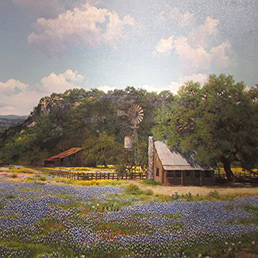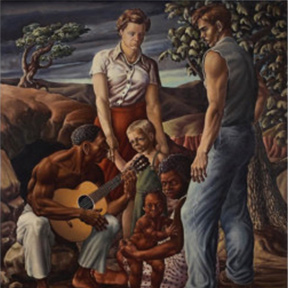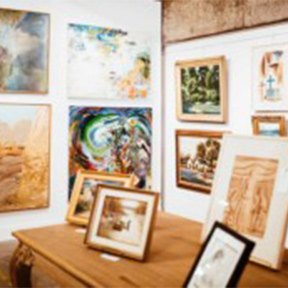- (214) 720-4044
- info@daviddike.com
- Mon - Fri: 10 am - 5 pm
Gonzalez, Xavier
Xavier Gonzalez
(Am. 1898-1993)
XAVIER GONZALEZ (Am. 1898-1993)
Born in the coastal city of Almeria, Spain, Gonzalez moved with his family at age eight to Seville, then shortly thereafter to Mexico, where they settled in Puebla in the state of the same name. At age thirteen, he studied art at the San Carlos Academy, Mexico City. His early training is reflected in a painting of a rural Texas scene executed when he was seventeen, probably painted on a visit with his uncle Jose Arpa, a former resident of Puebla who lived alternately in San Antonio and Mexico.
In 1916 Gonzalez studied mechanics by correspondence while working days in a draftsman’s office in Mexico and afterward for the Inter-Oceanic Railway and the Oro Mining Railroad Company. He traveled in Central America and Europe following World War I and in 1922 came to the United States to work for a railroad in Iowa, then as a window dresser for a department store in Chicago. Gonzalez returned to Mexico to teach briefly in public schools.
In 1925 Gonzalez came again to San Antonio to assist Arpa in his art school, which opened the following year. From 1927 through 1929, Gonzalez taught art classes at the Witte Memorial Museum. He studied several summers in New York and became a citizen of the United States in 1930. During the 1930s, he taught in Texas periodically at summer artists camps held at Glen Rose and Christoval, and from 1933 through 1939 he served as director of the Summer School of Art, Sul Ross State Teachers College, Alpine. In 1931 he accepted a teaching position at Sophie Newcomb College, New Orleans, where he married a student, Ethel Edwards of New Orleans, and in 1941 executed four murals for the U.S. Post Office in Kilgore, having previously painted murals in Los Angeles, New Orleans, and San Antonio. After an international competition his design was selected for the decoration of the Los Angeles Museum of Art (1933).
During World War II, Gonzalez worked in the War Department as an art director and executed a series of posters and special maps for the U.S. Navy. After the war, he lived on Cape Cod, Massachusetts, for ten years, where he founded a summer painting school in Wellfleet, then divided his time between Cape Cod and New York City. He painted, lectured at the Metropolitan Museum of Art, and taught in the art school of the Brooklyn Museum, the Art Students League of New York, and the painting school of Wellfleet. He received a Guggenheim Fellowship in 1947. Gonzalez was artist in residence at Western Reserve University, Cleveland (1953 – 1954), and at the El Paso Museum of Art (1965). He authored Notes about Painting (Cleveland: World Publishing Co., 1955) and in 1956 he was commissioned by Life to research and paint various monuments in Egypt; the oil paintings that resulted are now part of the collection at the Museum of Fine Arts, Boston. In connection with the American Bicentennial in 1976, he received commissions from the city of New York for a monument, which he executed in wood, polyester, and bronze, and from the U.S. Department of the Interior for a series of paintings. In 1987 Gonzalez received the Florence Brevoort-Eickmeyer Prize, awarded by Columbia University to an artist selected by the National Academy of Design. He died in New York City of Leukemia.
Collections: Museum of the Big Bend, Sul Ross State University, Alpine; School of Architecture, University of Texas, Austin; Dallas Museum of Art; Kendall Art Gallery, San Angelo; Marion Koogler McNay Art Museum and Witte Museum, San Antonio; San Antonio Art League; Corcoran Gallery of Art and U.S. Department of the Interior, Washington, D.C.; stone bas relief, library, Tulane University, New Orleans; Baltimore Museum of Art; Museum of Fine Arts, Boston; Wellesley (Massachusetts) College; Brooklyn (New York) Museum; Bicentennial monument, New York; Metropolitan Museum of Art and Whitney Museum of American Art, New York; Butler Institute of American Art, Youngstown, Ohio; Philadelphia Museum of Arts; Seattle Art Museum.





